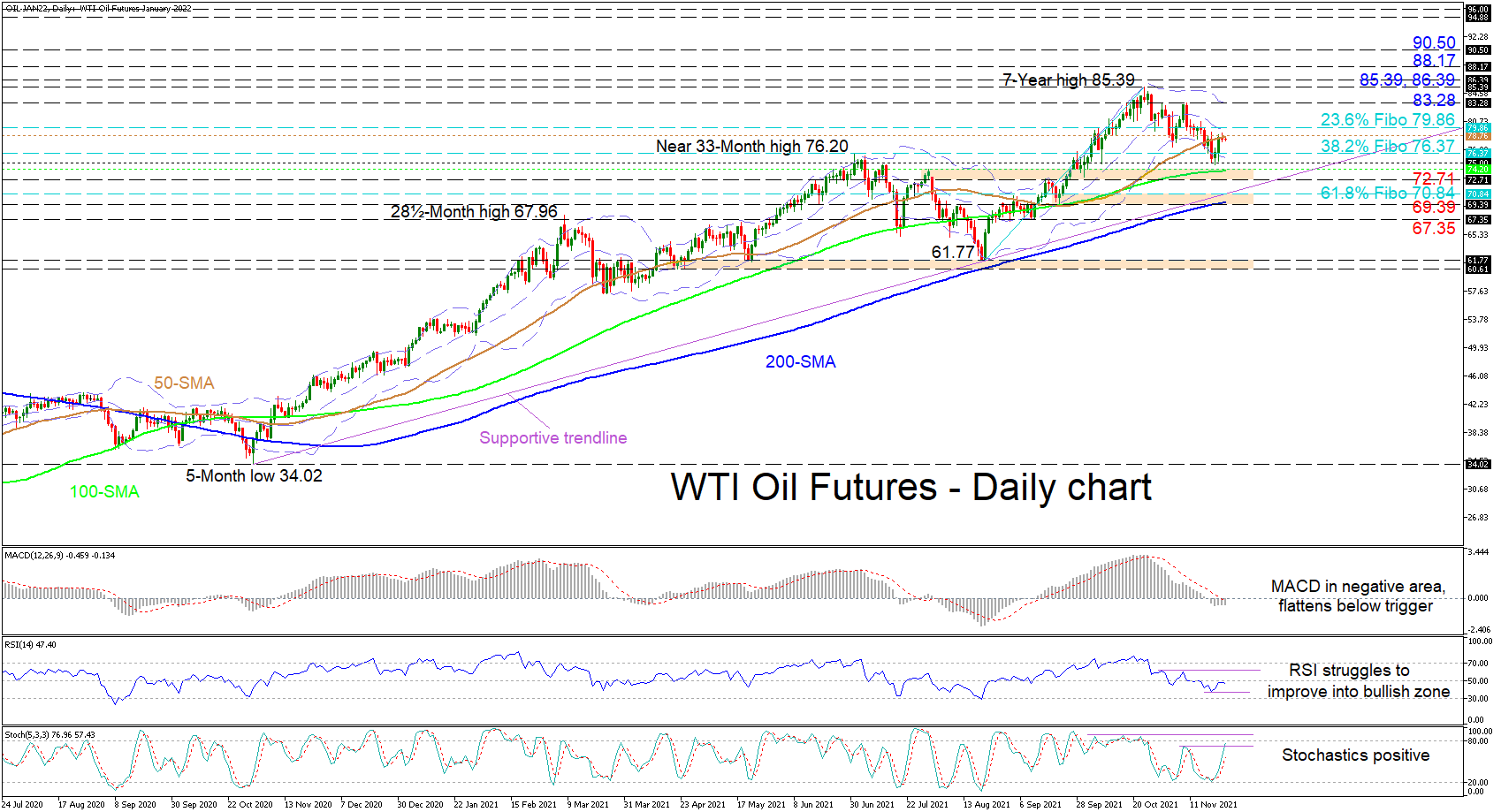WTI oil futures are striving to overstep the curbing 50-day simple moving average (SMA) after the pullback from the 7-year high rebounded at the 75.00 handle. The 200-day SMA is defending the bigger bullish structure, while the 50 and 100-day SMAs are endorsing the short-term uptrend in the pair.
The short-term oscillators are suggesting that the negative momentum may be running out of steam. The MACD is slightly in the negative region but is flattening below its red trigger line, indicating that negative forces are somewhat subsiding. That said, the RSI is signaling that upside forces are lacking a convincing upwards drive, while the positively charged stochastic oscillator is promoting gains in the pair.
In the positive scenario - reinforced by the lower Bollinger band - buyers could face an immediate zone of resistance between the 50-day SMA at 78.76 and the 79.86 level, which is the 23.6% Fibonacci retracement of the up leg from 61.77 until 85.39. Overstepping this, the price may push higher to test the upper Bollinger band at 83.28. If buying interest intensifies, the bulls could then challenge the seven-year high of 85.39 and the nearby 86.39 barriers, achieved in October 2014. Resuming the climb, the price may then target the 88.17 inside swing low from the early part of October 2014 and the 90.50 border.
If price gains remain capped by the 50-day SMA at 78.76, sellers could encounter preliminary downside limitations from the nearby 38.2% Fibo of 76.37, the lower Bollinger band and the 75.00 hurdles. Dipping past the 75.00 mark, an upside defence formed between the 100-day SMA at 74.20 and the 72.71 obstacle could prove to be a tough boundary for sellers to conquer. If bearish pressures persist, a possible supportive trend line, pulled from the 34.02 trough could deter a deeper decline from challenging the 69.39-70.84 buffer zone, where the 200-day SMA also resides. Slightly lower, the 67.35 barrier could be a critical defense to cement a return of the bearish bias in the bigger picture.
Summarizing, WTI oil futures are sustaining a bullish bearing above the 75.00 psychological number and the 72.71-74.20 support band. Negative concerns could grow with a dive past the 69.39-70.84 boundary.
Forex trading and trading in other leveraged products involves a significant level of risk and is not suitable for all investors.
Recommended Content
Editors’ Picks
EUR/USD holds below 1.0750 ahead of key US data

EUR/USD trades in a tight range below 1.0750 in the European session on Friday. The US Dollar struggles to gather strength ahead of key PCE Price Index data, the Fed's preferred gauge of inflation, and helps the pair hold its ground.
USD/JPY stays firm above 156.00 after BoJ Governor Ueda's comments

USD/JPY stays firm above 156.00 after surging above this level on the Bank of Japan's decision to leave the policy settings unchanged. BoJ Governor said weak Yen was not impacting prices but added that they will watch FX developments closely.
Gold price oscillates in a range as the focus remains glued to the US PCE Price Index

Gold price struggles to attract any meaningful buyers amid the emergence of fresh USD buying. Bets that the Fed will keep rates higher for longer amid sticky inflation help revive the USD demand.
Bitcoin Weekly Forecast: BTC’s next breakout could propel it to $80,000 Premium

Bitcoin’s recent price consolidation could be nearing its end as technical indicators and on-chain metrics suggest a potential upward breakout. However, this move would not be straightforward and could punish impatient investors.
US core PCE inflation set to signal firm price pressures as markets delay Federal Reserve rate cut bets

The core PCE Price Index, which excludes volatile food and energy prices, is seen as the more influential measure of inflation in terms of Fed positioning. The index is forecast to rise 0.3% on a monthly basis in March, matching February’s increase.
